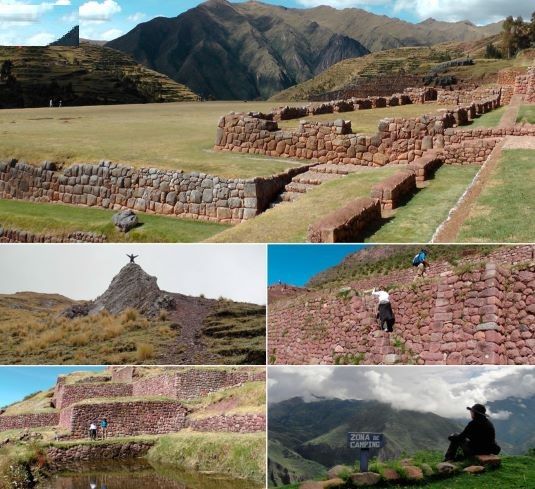Huchuy Qosqo was a town located at more than 3,550 m.a.s.l. on a small plateau at the top of a mountain. From here you can take beautiful views of the other side of the valley, it is possible to appreciate snow-capped mountains of exuberant beauty such as the snow-capped Pitusiray and at the bottom of this privileged view, the town of Calca.
It is known by the chroniclers that it was the Inca Wiracocha who ordered the construction of the city of Huchuy Qosqo in Cusco.
It is said that in his old age, he felt tired and wanted to leave the government and get away from the movement of the capital of the Tahuantinsuyo empire (Cusco) and seek peace and tranquility in this place; It is built on a territory occupied by several human settlements, over time, these would be dominated and incorporated into the empire of the Incas. One of these settlements must have been precisely on Huchuy Qosqo.
Where is Huchuy Qosqo located?
Huchuy Qosqo is located in the peasant community of the same name, just less than 5 km from the city of Calca in the department of Cusco, in the Sacred Valley of the Incas; exactly on a summit at 570 m. on the Urubamba river basin (Vilcanota). The Huchuy Qosqo route is very beautiful; walking its trails will allow you to visit some Andean communities, archaeological centers and enjoy beautiful landscapes. Many people take advantage of visiting Huchuy Qosqo on their trip to Machu Picchu.
What does Huchuy Qosqo mean?


Huchuy Qosqo means “Little Cusco“, but it also has other names; one would be Qaqyaxaqixawana and another Qaqyaqhawana, this means “from where the rays are observed”;
And without a doubt it is a good name since being 800 meters above the Sacred Valley of the Incas, gives you the opportunity to see the dramatic light and sound show, at the moment when lightning and thunder descend from the sky to crash against the floor. Others say that the site was probably known in Inca times as “Caquia Jaquijahuana”.
Huchuy Qosqo Ruins
The enclosure located in Huchuy Qosqo, is called Qaqyaqawana; Quechua name that refers to the place where the lightning is seen.
This archaeological complex is located in the upper third of the mountain called Qaqya (thunder), and exhibits one of the most impressive works of topographic modification through the use of terraces, modulating the edges of precipices and vertical ravines on the Vilcanota Valley,
culminating on platforms that were used as ceremonial esplanades, around which several architectural structures made of stone and adobe can still be found standing. Materials used and worked with great criteria, achieving a fine finish.
In addition, the structures of the enclosure are distributed in such a way that they architecturally resemble the city of Cusco; It is for this reason that at the beginning of the 20th century it received the name of Huchuy Qosqo (small Cusco).
One of the most outstanding characteristics of this archaeological complex is the use of lithic material combined with adobe and clay. This shows the knowledge and mastery of the different construction materials, used with high technology, especially adobe; The centuries-old walls built of this material still defy the severe inclement weather in the area, seismic movements and of course the passage of time.
What to see in Huchuy Qosqo?
Here is a list of what you can see at Huchuy Qosqo ruins; At the moment you do not need any ticket, or pay to enter to Huchuy Qosqo in Cusco.
A structure with three levels (floors), the first two in the form of regular polyhedra, and the last floor made of adobe. The enclosure is rectangular in shape and enormously architectural.
A long rectangular building made of adobones on an eminent platform, this building has a large number of doors facing the valley.
You will find many other smaller enclosures scattered in Huchuy Qosqo ruins, most of them are in poor condition. Very close to these ruins, you will find an Inca trail oriented to Cusco Inca trail oriented to Cusco. Also some small loose enclosures such as outposts and surveillance located on the edge of the precipice, in order to have the greatest possible visual field of the valley.










